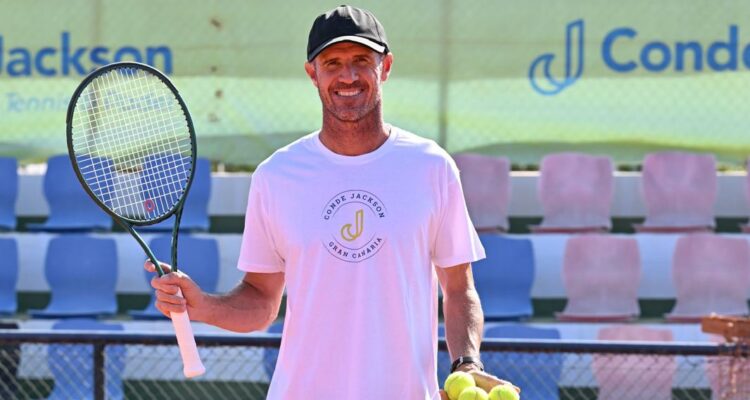TELDE/GRAN CANARIA, May 22, 2025
He once shared the court with Rafael Nadal, cracked the Top 750 in the world rankings, and traveled the Pro Circuit chasing his tennis dream. Today, 43-year-old Marcos Conde-Jackson lives in Telde, Gran Canaria, where he has channeled his passion into developing the sport on his home island.
A former World No. 727, Conde-Jackson now co-runs two tennis clubs – one in Maspalomas and one in Las Palmas – and plays a key role in organizing international events, including an ITF World Tennis Tour W100 tournament. In this interview, the Spaniard reflects on his playing days, the challenge of pursuing tennis from a remote island, and his hopes for the next generation of Canarian talent.
Sieh dir diesen Beitrag auf Instagram an
Tennis TourTalk: Marcos, can you tell us a bit about your tennis career.
Marcos Conde-Jackson: I started to play tennis with my family when I was eight years old. I left Gran Canaria at the age of 18 and started to practice in Mallorca. I came back two years later. After my professional career, I worked at a tennis school. Then, my brother Dominic and I founded our own club. Today we have two clubs – one in Maspalomas in the south of the island and the other in Las Palmas, the capital city of Gran Canaria.
What makes it so special to play tennis in Gran Canaria?
It’s a paradise and the perfect place to start a career. The weather is always nice with at least 20 degrees Celsius during the winter and the summer is not too hot. We have a bit of wind, but this is also good to get used to these kinds of conditions. The most challenging part is probably the distance from the Spanish mainland and Europe. When I was young, it was hard to travel but nowadays it’s easier. There are many opportunities to come here for a couple of weeks to practice.
Where are your students from?
Our tennis school is smaller and not that big like some of the famous Tennis Academies in Spain. We have a lot of good players, but they are all from the Canary Islands. That’s our goal. We focus on the players from the archipelago, trying to help them. When they become older and want to go for more, we can give them some advice where to go in Spain in order to continue developing their career.
What can you tell us about the facilities you provide?
We started to run the Tennis Club in Las Palmas 10 years ago. There are only hard courts. Five years ago, we added Maspalomas, where we provide seven clay courts and two hard courts.
The venue in Maspalomas also hosted international tennis events.
We organize an annual ITF World Tennis Tour Womens event there. We started about five years ago with an ITF W50 tournament. Then we decided to do a big jump and upgraded it to an ITF W100 event the past years. Earlier in the season, we received an award from the ITF for ‘Excellence in organization’. We have been working hard for this. Our tournament director Oti Santana and her team do a wonderful job. We also organized an ATP Challenger Tour event for two years. Unfortunately, we had to cancel last year’s edition, as we lost a big sponsor.
#Tenis El ITF W100 DISA Gran Canaria, premiado por su excelencia
La Federación Internacional de Tenis galardona al torneo que se celebra en Maspalomas como uno de los mejores del circuito mundial pic.twitter.com/a2addrWhgV
— Todo Goles Radio (@TodoGolesRadio) April 14, 2025
What are the chances that the ATP Challenger Tour event returns to Gran Canaria?
I hope that the Circuit will be back. But you need to invest a lot of money. Our main event is the women’s tournament. We will try to focus on this event and come back stronger in the future to host another Challenger tournament.
You were also a player on the Pro Circuit. What are the differences between the days of your active career and today?
That’s a difficult question. When I was a young player, I always heard that it was harder in the past. The same thing I told later in my career (smiles). The veterans of the tour often say it was tougher when they started their careers. I don’t know but your mindset changes when you become older. You are more experienced and see things differently. The tournaments, however, are more professional nowadays. The material has also changed. You have to use new strings, a new overgrip. The costs have increased. Many players cannot afford it anymore.
You also competed against some interesting players. One of them was Rafael Nadal. You played him at a Futures Event in Madrid in 2002. What are your memories of this match?
This was the third time I played against him but for the first time at an international tournament. Before we met at national level. I remember it was 6-1, 7-6. The tournament took place on a fast hard court, and I passed the qualification. I was playing serve and volley throughout the tournament. I won the first round of the main draw and before facing Rafa I called my brother and told him that it would not be a good idea to stick to the serve-and-volley style. He told me that when I feel comfortable that way, I should go for it. And I tried it, but I lost the first set 6-1. He was passing me from every place on the court. So, I changed my tactics for the second set, playing from the baseline and I got better into the match and made it into the tie-break. It was very tough.
What about the matches at national level?
The first time I played him; he was 14 or 15 and I was 19 years old. It was on clay, and he beat me pretty easily. I knew him because we lived and practiced together in Mallorca. He was like a tsunami. The second time, he beat me in three sets.
Could you already see that he would become one of the best tennis players of all time?
Yes. My brother asked me how I could lose against a 14-year-old, but our coaches told him that this guy is a different level. Just see what happened afterwards.
What happened with your own career?
I tried my best until I was 23. My best ranking was World No. 727. It was hard for me and my family to finance it. I had support but it wasn’t enough. My last best result was beating Benjamin Becker in 2005. It was the year when he studied in the United States, and we met at a tournament in Römerberg. I won against him in a national tournament. Then, I decided to finish my career. Benjamin on the other hand sent Andre Agassi into retirement at the 2006 US Open. I was at home, watched it on TV and couldn’t believe it. That was my last memory of my professional career before I started to work at the tennis school.
Thank you and all the best.
Interview: Florian Heer





